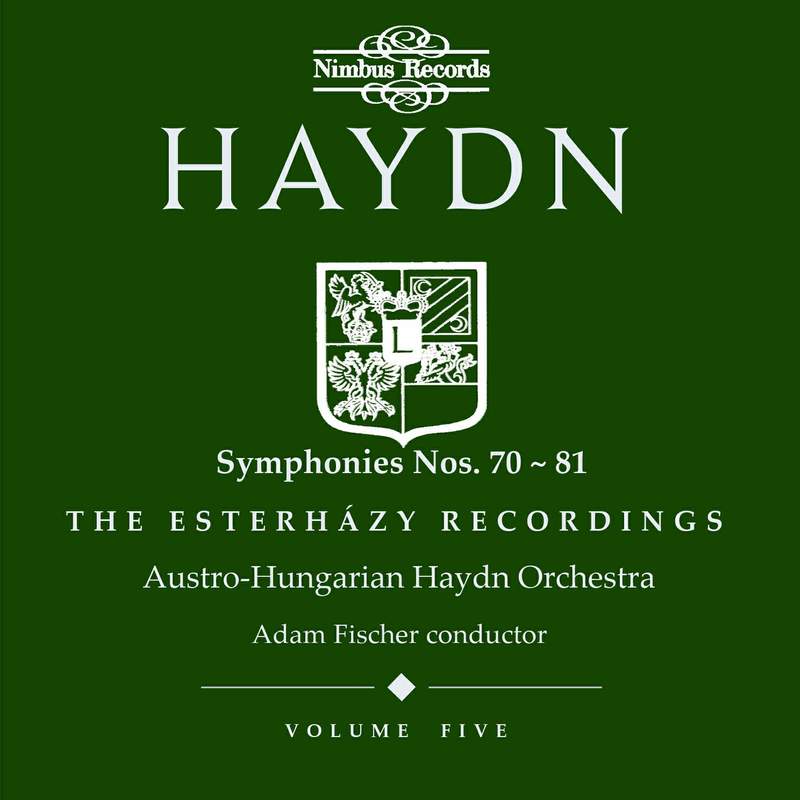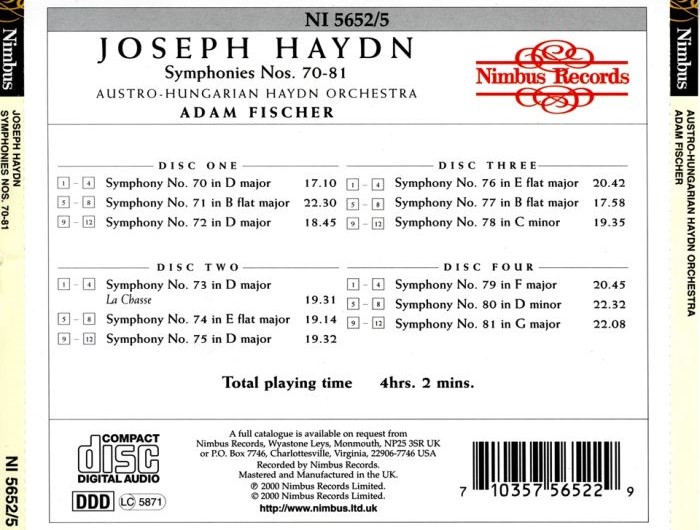Haydn: Symphony 70 - 81
As the sets contain less symphonies as I move to higher Hoboken numbers, I will obviously have less to talk about.
If I have noticed any trends across this set of twelve symphonies, one aspect would be more graceful and elegant outer movements. I often use the terms genial, dainty, gentille, or gentrified to describe these portions which were previously muscular or heavier.
I don't know if this gentle aspect is a galante style coming from Haydn, something I was expecting earlier from the composer, or if this was a trend of the time. I mention Rossini when I cover the individual symphonies occasionally, simply because the opening movements sometimes remind me of that composer, so perhaps this is what the gentry expected around this time.
Also, the Theme and Variation and Rondo forms have really caught on to Haydn's quill, particularly in the second and fourth movement positions. In the last couple of symphonies, I have noticed the second-movement song form come back, but otherwise, I expect a Variation or Rondo to appear.
While the Minuet continues apace, the Trio almost always features a unison or octave pairing on melody. Usually this includes the first violin with a wind instrument. Additionally, where the Trio was usually set in a contrasting key or mode, in this volume, the home key is maintained for the most part.
Nicknames
The Chase (73)
Of course, this set contains only twelve symphonies, but there is a relative dearth of nicknamed symphonies in this set. Horn lovers should rejoice, though...
Opening Tempo & Tempo Markings
Slow Intro: Three (71, 73, 75)
I thought I would be talking more about slow introductions, and there is a trio of them, but generally, this aspect has not caught fire quite yet.
There is one opening Presto marking, and it follows a slow introduction marked Grave. The latter is never seen in Haydn, so for the composer to pair it with the rare opening Presto must have some sort of purpose. To add to the oddities, the Presto is set in a common 4/4 time.
Instruments
Flute: All
Trumpet: 70, 73, 75
Timpani: 70, 72, 73, 75
Ah... the flute is a regular member now. Flute provides a lovely contrast to the more nasal oboe, although two flutes would be even better.
Initial Time Signatures
3/4: Five
4/4: Five
2/4: Two
Nothing really to speak of here. Of the three symphonies which open in a slow movement, the faster tempo always switches to a different time signature. I only count the fast tempo proper in the list above. Thus, when Symphony no. 71 begins in a 4/4 Adagio, it is followed by a 3/4 Allegro, whereas Symphony no. 73 starts in a 3/4 Adagio, therefore a 4/4 Allegro continues on afterwards.
Title Key Signatures
Sharp: Five
Flat: Seven
C Major: Zero
Minor Key: Two
Homotonal: One
Despite the lack of C-Major keys, trumpets show up at least three times, and timpani four. I noticed the preponderance of flat keys too, especially in the higher numbered symphonies.
While there are two minor keys here, I never felt like Haydn's heart was really in it. Symphony no. 80 in D minor never really returns to minor after he leaves it in the middle of the first movement. In that symphony, the first part of the Minuet set in D minor can't wait to get away from it either, and the final movement is simply set in D Major altogether. A similar occurrence happens in Symphony no. 78 in C minor. Conversely, Symphony no. 70 in D Major can't wait to turn to D minor in the second and fourth movements.
Only one symphony remains homotonal, Symphony no. 70, and I just spoke to its wont to turn to the parallel minor.
Length
To my mind, the second movements have been longer in general, either due to their importance, or the Rondo / Theme and Variation forms which have steadily increased during this movement slot.
Also, the first movement Sonata-Allegro forms have sounded more fleshed out, particularly those written for entities outside of the Esterházy employ. So too, when the Rondo appears in the final movement, that portion usually takes up more runtime.
Haydn's Paris Symphonies are up next, while the London Symphonies won't be too far behind either. This also means I am reaching Haydn's maturity as a symphonist. The history of Haydn as a dedicated servant comes to an end as well, where the composer gets to spread his wings to places (both physical and musical) he had never trod before.
Yet, I know as I get to the later, more popular symphonies, Ádám Fischer and the Austro-Hungarian Haydn Orchestra become less competitive on record. Some of this is due to Fischer beginning with the well-known symphonies before he and the orchestra developed a simpatico relationship, and before the Nimbus engineers tamed the acoustic environment in the Esterházy Palace Haydnsaal. But also, the major conductors of today and yesteryear all put their hand on Haydn's late symphonies, with some truly brilliant minds set to his music.
Too bad, since these later Middle Symphonies from Haydn, and recorded between 1996-98, have been some of the project's finest, both from a music direction standpoint, as well a sonic listening view. I hate to leave that behind!
Find more Haydn recordings HERE!



Comments
Post a Comment